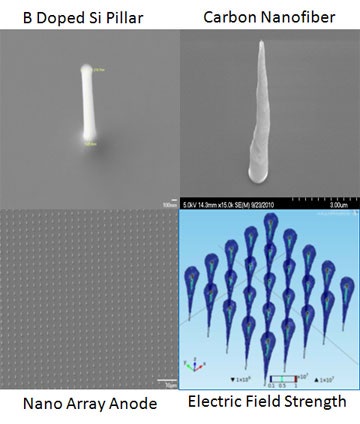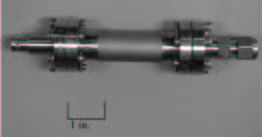Tech Briefs
Savannah River National Laboratory
Boron-Structured Nano-Proportional Counters
Scientists at the Savannah River National Laboratory (SRNL) have explored the use of nanotechnology to improve the design of gas-filled proportional counters (PC). The new nano-detector design will require a much lower operating voltage, a smaller power supply, enhanced portability, increased sensitivity to radiation, and improved detection efficiency.
Background
SRNL has investigated an alternative to conventionally constructed gas-filled PCs using a boron-coated nanostructured array affixed on an insulating substrate to replace the traditional PC wire anode. Use of nanostructures can reduce the required operating voltage by more than 100 times compared to traditional PCs due to the inherently high electrical fields associated with nanoscale anodes. Furthermore, the new model will eliminate the need for scarce resources, making it a more economically feasible design for the future; coating the arrays with layers of boron-10 allows for the detection of neutrons without the use of Helium-3, an isotope in considerably dwindling supply.

At a glance
- Portable
- Easily used by one person
- Detects gamma and neutron radiation
- Quickly covers large area
- U.S. Patent 7,351,982
How it works
Nanomaterials have garnered a lot of interest due to their unique physical, chemical, and most notably, electrical properties. It has been shown that the ability to generate very high electric fields around conductive nanostructures at low voltages can be attributed to their nanoscale alone. As a result, gas multiplication occurs at significantly lowered potentials, facilitating compact design, low voltage battery operation, and safe operation of these detectors. When coated with boron-10, which has a large neutron capture cross section, neutrons can be detected through the gamma rays and alpha particles resultant from their interaction with the boron atoms.
The use of nanoscale arrays as anodes enables the design of electric fields that improve detection of ionizing radiation. Doping the anodes with boron allows for practical and low-cost neutron detection. Overall, boron-based nano-PCs have the potential to renovate the age-old design of PCs and lead the way for the advancement of radiation detection technology through use of nanomaterials.

Lab prototype
Stage of development
This technology is in early stage research and development with ongoing testing underway. Two types of nanoscale anodes (boron-doped Si pillars and carbon fibers) have been fabricated and tested. Early modeling and laboratory studies have demonstrated that there is a considerable reduction in voltage required to reach the proportional counting region, but detector design has not been optimized. Nano-PCs can potentially be used as detectors for illicit trafficking of radioactive material, dosimeters, tritium gas monitors, handheld radiation detectors, and environmental sensors. A patent has been filed with the U. S. Patent and Trademark Office.
Partnering Opportunities
SRNL invites interested companies with proven capabilities in this area of expertise to develop commercial applications for this process or product under a cooperative research and development agreement or licensing agreement. Interested companies will be requested to submit a business plan setting forth company qualifications, strategies, activities, and milestones for commercializing this invention. Qualifications should include past experience at bringing similar products to market, reasonable schedule for product launch, sufficient manufacturing capacity, established distribution networks, and evidence of sufficient financial resources for product development and launch.
Download Tech Brief
Contact Information
Savannah River National Laboratory
E-mail: partnerships@srnl.doe.gov